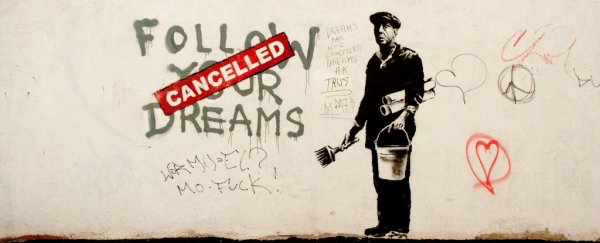Those who are familiar with the viral street artist Banksy will be aware that his identity has been one of the art world's most closely guarded secrets for the past 20 years. But now scientists have released the name of the man who - mathematically speaking - they predict is most likely to be Banksy.
To figure this out, the team analysed the location of more than 140 of Banksy's artworks around the UK, and used an algorithm to determine how likely it was that a leading suspect could have created them, based on where he was living at the time. And if you don't want any spoilers, now is the time to stop reading.
According to the researchers, the man most likely to be Banksy is UK resident Robin Gunningham. For fans, that won't come as a surprise - Gunningham was named by The Daily Mail as being the artist back in 2008. But this is the first time that science has been used to back up that claim - and while Banksy's team hasn't confirmed or denied the findings, according to the BBC, they tried to stop the paper from being published.
Below is the only publicly available image of Gunningham, from The Daily Mail's front page:
 The Daily Mail
The Daily Mail
While it's kind of a bummer that the identity of Banksy might now be one less mystery in the world, the research is a demonstration of how powerful a new technique called Dirichlet process mixture (DPM) model can be when it comes to solving crimes.
Right now, geographic profiling tools used by police simply take into account one place of reference - usually a suspect's house - and expects to see a somewhat circle-shaped pattern of crime scenes appearing around it. But the DPM model also factors in that crimes could be committed away from home too - for example, near places of employment, pit stops along a commute, or favourite pubs - and runs an algorithm to identify the most likely sources of crime scenes, with an accuracy of up to 50 metres.
To test the system out on Banksy, a team from Queen Mary University of London programmed in more than 140 of his artwork locations around the UK to see whether there was any connection with places Gunningham has been known to live and hang out.
They found that, although Banksy's art is spread out across 400 square kilometres in London, the peak of the activity is less than 500 metres from Gunningham's wife's former address, and close to the house that Gunningham used to live in. Coincidentally, Bristol is another hot-spot of Banksy activity, and is also where Gunningham grew up.
"The case hinges on a number of striking coincidences between Banksy and Robin Gunningham. First, both appear to have spent their early years in Bristol. [And then] Banksy moved to London around 2000, as did Robin Gunningham," lead researcher Steve Le Comber and team write in the Journal of Spatial Science. "This analysis does provide some support for the theory that [Gunningham] is Banksy," the authors conclude.
Of course, with no other suspects to look into, it's impossible to say conclusively that Gunningham is Banksy. This is pretty much a study being run without a control, and there's no way to know that there aren't more likely candidates out there.
What the research does demonstrate is that the DPM model can be used to accurately identify hang-outs of potential criminals, based on patterns of illegal activity. The team is now using the system to map the origin of disease outbreaks, and hopes that it could one day be used to stop terrorist networks, based on the patterns of vandalism and anti-government activity known to occur in the lead up to an attack.
When you think about it, Banksy really just took one for the team in the name of scientific progress. Whoever you are, we salute you.
